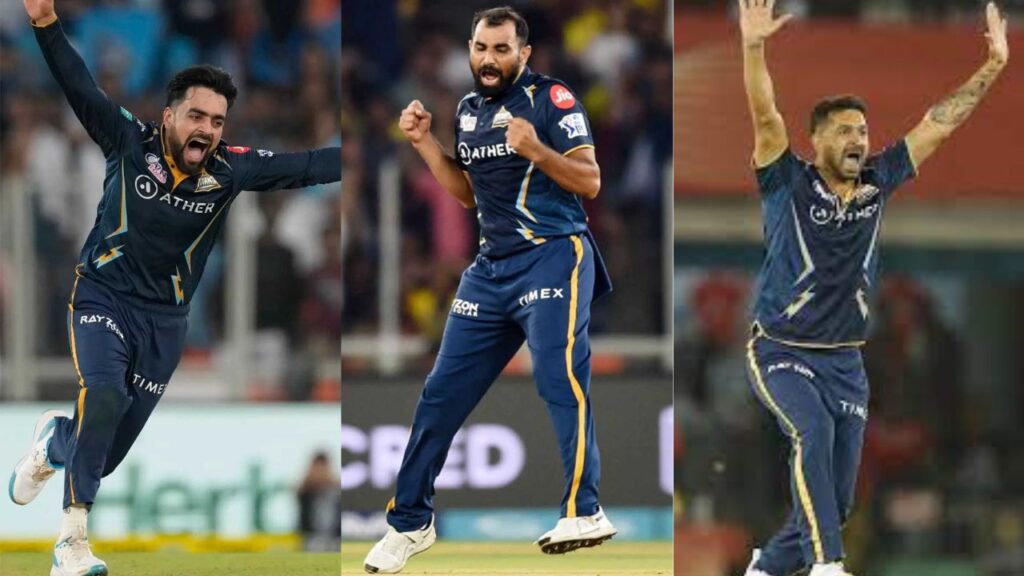
What do you picture when you think of the Indian Premier League (IPL) or Twenty20 cricket in general? Last-ball finishes? Sixes launched deep into the stands, or even out of the ground? Shubman Gill taking a bow after yet another century? Subconsciously, most of us associate the format with big-hitting batters. What the Gujarat Titans have proved this season, while winning 10 regular-season games and reaching a second straight final, is that T20 isn’t that different from the other formats. Bowlers win you matches, especially when they perform clearly defined roles within the unit.
The numbers are quite staggering. For the first time in the history of the tournament, the top three wicket-takers are all from the same team. And unless Tushar Deshpande has the game of his life in the final for Chennai Super Kings, the top three will stay as is, even if the order may change.
What is even more remarkable is that each of the three – Mohammed Shami, Rashid Khan and Mohit Sharma – has had the best IPL season of their careers in terms of numbers. In the case of Shami and Rashid, they have beaten their previous benchmarks by a distance. As for Mohit, who hadn’t even taken 10 wickets in a season since 2017, his renaissance is one of the most eye-catching stories of the tournament.
Also Read: “The Idea was to Length” – Mohit Sharma on solving the SKY Puzzle
In his first half-decade in the league, when he played mostly for Delhi Daredevils, as the team was then called, Shami was a liability who leaked runs and didn’t take wickets. A switch to Punjab Kings, with Anil Kumble as coach, transformed his IPL career. He took 58 wickets in his three seasons there, in an otherwise inconsistent team, and his maiden campaign with Gujarat in 2022 saw him finish with 20 wickets and an economy rate of 8.00.
This season, Shami already has 28, while conceding just 7.95 an over. At times, he has been nearly unplayable in the Powerplay with the combination of pace and subtle movement. Rashid’s case is even more interesting. He has gone for far more runs this season than in the past – an economy rate of 7.94, as compared to 6.38 in his first six years in the league – but his haul of 27 wickets is six more than his previous best (21 in 2018).
As for Mohit, his 24 wickets and economy rate (7.89) are both better than he managed in 2014, when he won the Purple cap. Hardik Pandya tends to use the three in different phases of the innings, and it helps that he can also call on Afghanistan’s Noor Ahmad, currently 15th in the wicket-takers’ charts with 14 at a fine economy rate of 7.96.
What this has generally meant that is that opposition teams usually get no respite against the Titans. While Alzarri Joseph hasn’t quite clicked this season, Ireland’s Josh Little has bowled some tidy spells to back up the main men. This strength in depth is especially important when you consider that Gujarat have only one batter in the top 25.
Shubman Gill sits pretty at the top of the list on 851 runs. Gujarat’s next-best batter has been Vijay Shankar, whose 301 runs have come at a superb strike-rate of 160. Pandya (325) and Wriddhiman Saha (317) have both made a few more runs, but neither has been anything like as consistent or aggressive.
Only twice before have bowlers from the same franchise finished first and second in the race for the Purple cap – Sohail Tanvir (22 wickets) and Shane Warne (19) for Rajasthan Royals in 2008, and Lasith Malinga (28) and Munaf Patel (22) for Mumbai Indians in 2011. What makes the Titans so remarkable is the presence of a third, and even fourth, gun bowler.
It isn’t a coincidence that Ashish Nehra, Gujarat’s chief coach, was a white-ball bowler of some quality himself. Unlike others who sit back and observe, or get the analysts to try and make sense of the data, Nehra is constantly prowling the boundary line. Often, you’ll see him in conversation with Pandya, or with individual bowlers. Apart from the wickets that they’ve taken, what really sets apart Gujarat’s bowling unit is the clarity with which they’ve gone about their tasks.
It isn’t a case of running in, rolling the arm over and hoping for the best. Gujarat have consistently choked off the runs in the Powerplay, with Rashid and Noor then controlling the middle of the innings. Mohit’s nous and variations have proved too much for many batters at the end.
The final challenge remains. Devon Conway and Ruturaj Gaikwad have frequently given Chennai fast starts, while Shivam Dube has been hitting sixes for fun. The likes of Ravindra Jadeja, Moeen Ali, Ambati Rayudu and MS Dhoni haven’t done much so far, but Gujarat will plan taking into account the fact that each is capable of a match-turning knock.
There is significant experience on both sides, and Pandya has already shown that he is probably Dhoni’s natural successor in terms of style and composure. But whatever happens in the final, what Gujarat have shown us this season is that it’s certainly not just a batters’ game. If you have the bowling arsenal and the astuteness to use it well, they will win you plenty of matches. Maybe even a final.
Also Read: In-form Shami can be India’s Top Dog at WTC Final



